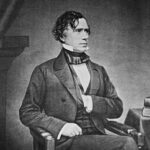President Franklin Pierce signed the Kansas-Nebraska Act on May 30, 1854. This legislation fundamentally altered America’s approach to slavery expansion. The act repealed the Missouri Compromise of 1820, which had prohibited slavery north of the 36°30′ parallel.
The Kansas-Nebraska Act’s Core Provisions
The new law created two territories: Kansas and Nebraska. It introduced “popular sovereignty” as the method for deciding slavery questions. ⚠️ This meant territorial residents would vote on whether to allow slavery. Pierce believed this approach would reduce federal tensions over slavery. However, the decision proved catastrophically divisive.
Political Maneuvering Behind the Decision
Senator Stephen Douglas championed the Kansas-Nebraska Act in Congress. He needed Southern support for his transcontinental railroad plans. Pierce initially hesitated but eventually endorsed the legislation. 📊 The bill passed the Senate 37-14 and the House 113-100. Pierce signed it despite knowing the potential consequences.
Immediate Opposition and Criticism
Northern abolitionists immediately condemned Pierce’s decision. They viewed it as a betrayal of the Missouri Compromise’s protections. Free-soil advocates organized mass protests across Northern cities. 💰 The act also threatened the economic balance between free and slave states.
Impact:
The Kansas-Nebraska Act triggered immediate and long-lasting consequences across America. Pierce’s decision fundamentally reshaped national politics and accelerated sectional divisions. The legislation’s impact extended far beyond territorial organization.
Bleeding Kansas Erupts
🔥 Violence erupted almost immediately in Kansas Territory. Pro-slavery “Border Ruffians” from Missouri crossed into Kansas to vote illegally. Anti-slavery settlers poured in from New England and other Northern states. The competing factions established rival governments in Kansas. Armed conflicts broke out regularly between 1854 and 1859. John Brown’s anti-slavery raids epitomized the territory’s brutal violence.
Political Party Realignment
The Kansas-Nebraska Act destroyed the existing two-party system. The Whig Party collapsed under sectional pressures. Northern Democrats abandoned Pierce and popular sovereignty. 📉 The Republican Party formed in 1854, uniting anti-slavery factions. Pierce lost control of his own Democratic Party. His political career effectively ended with this single decision.
Path to Civil War Accelerates
The act made compromise between North and South nearly impossible. It radicalized both abolitionists and pro-slavery advocates. Sectional tensions reached unprecedented levels after 1854. 🌍 International observers began questioning America’s democratic stability. The legislation proved that popular sovereignty couldn’t resolve slavery peacefully. Pierce’s decision pushed the nation inexorably toward armed conflict within seven years.
